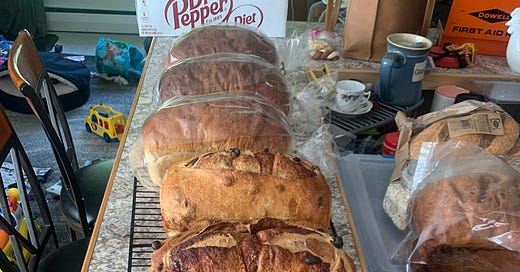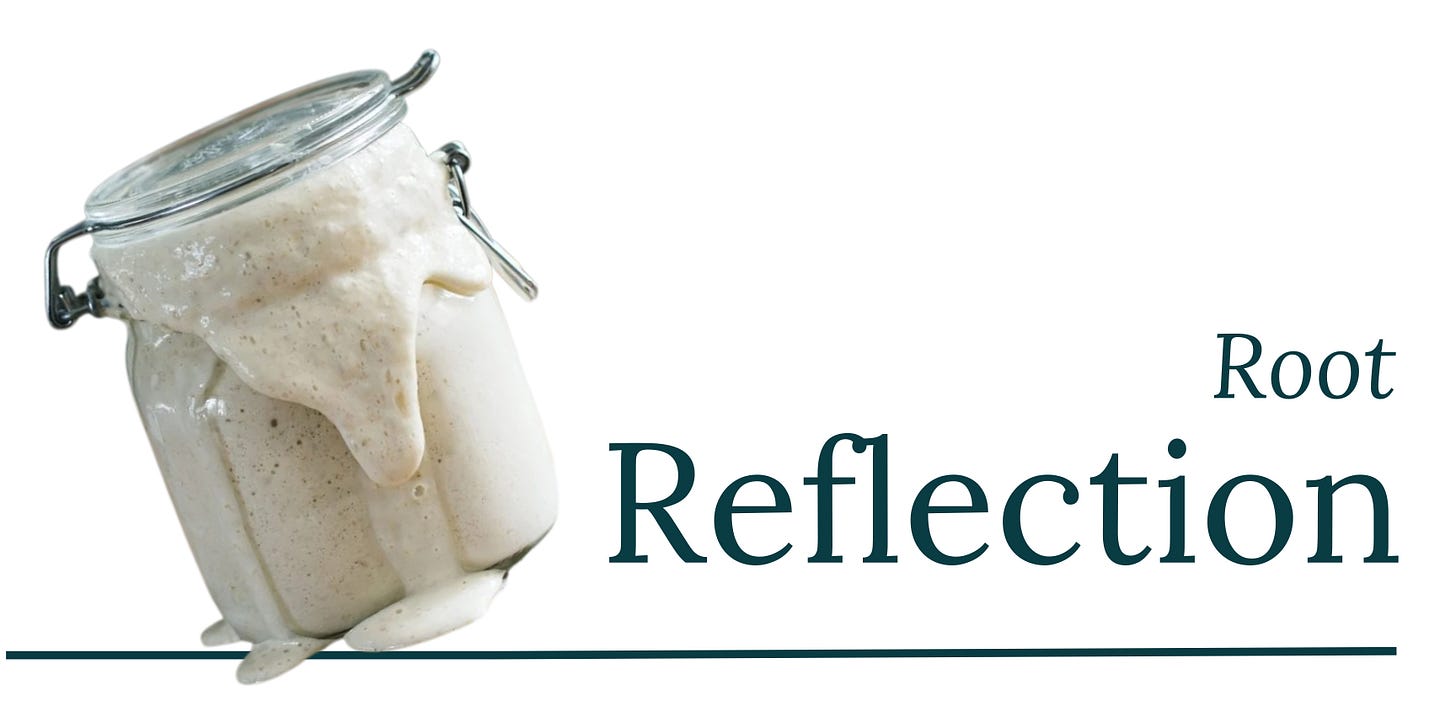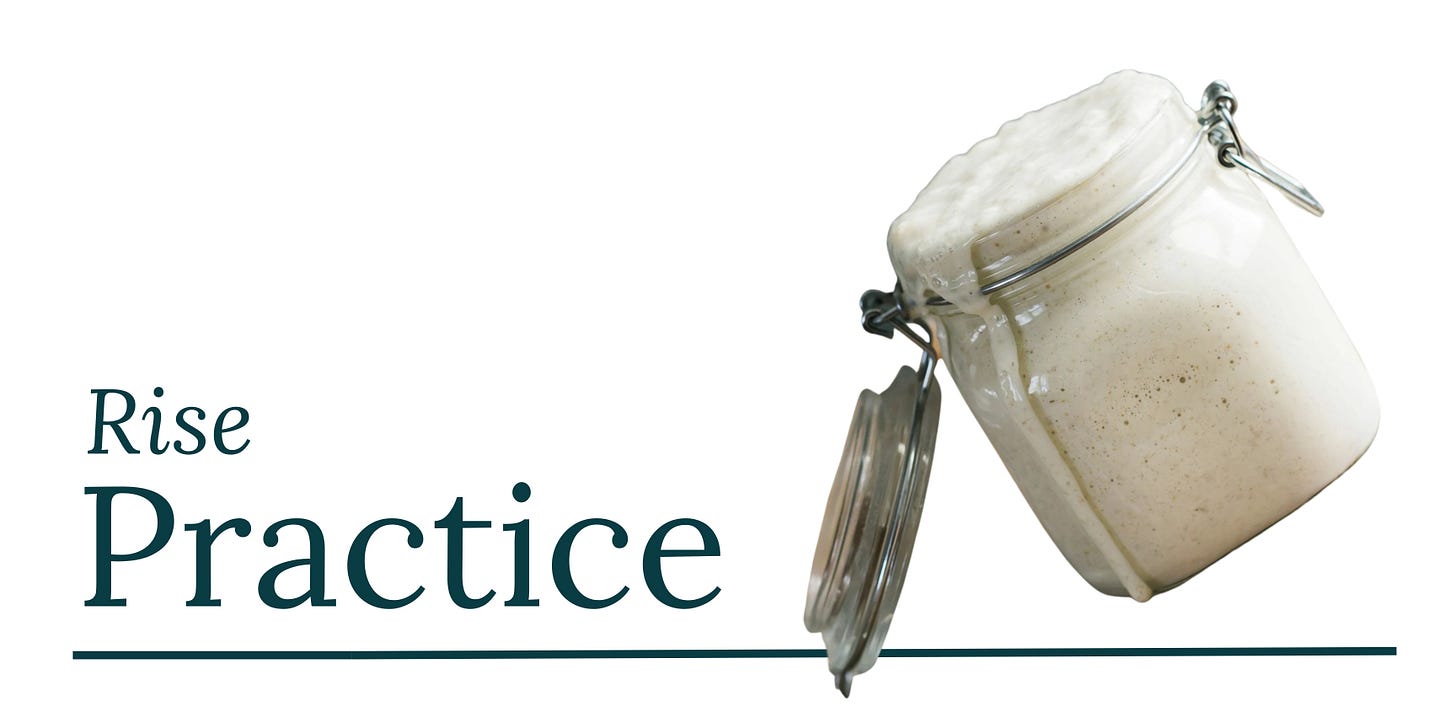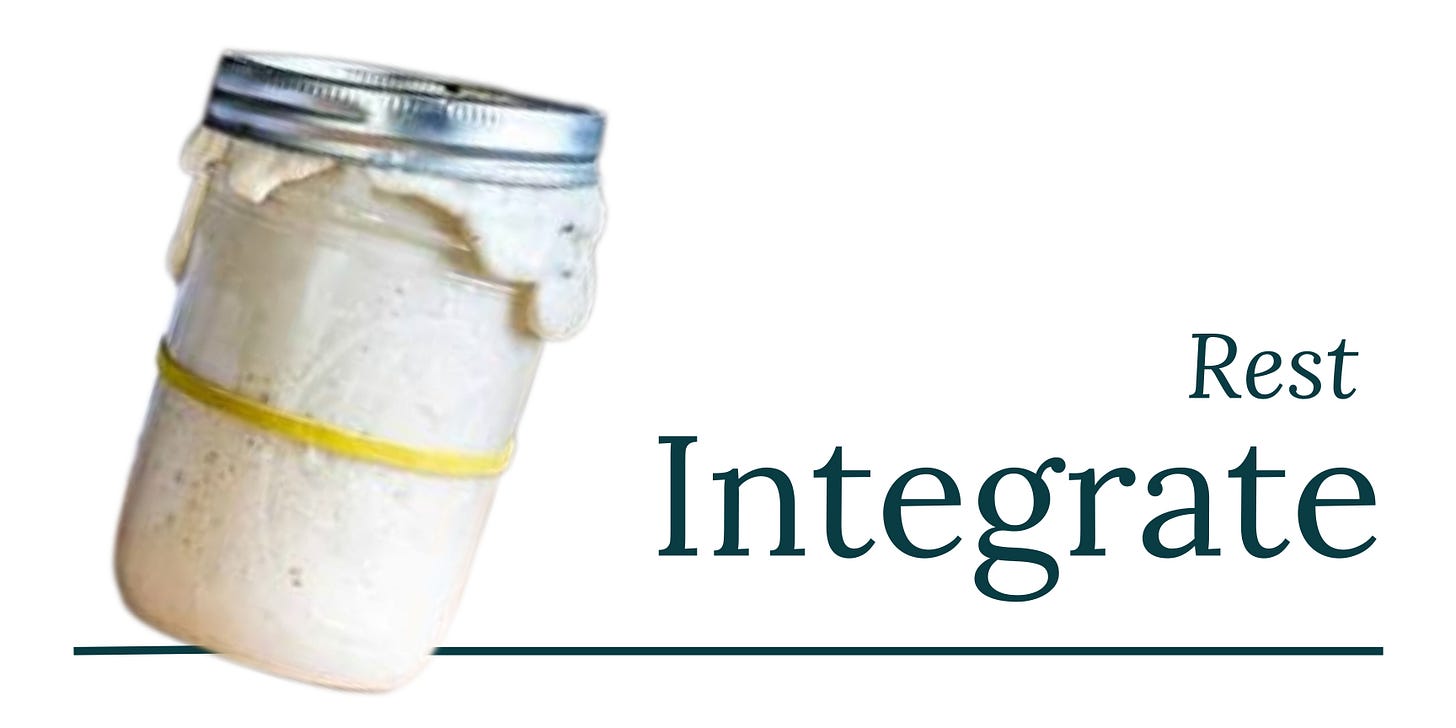Feeding What Heals. Starving What Hurts.
A reflection on sourdough, spiraling, and the slow work of choosing differently
You become what you give your energy to.
-Marcus Aurelius
The mind is everything. What you think you become.
-Buddha
The first time my mom’s sourdough starter exploded, I thought someone had fired a gun in her kitchen.
We’d just gotten my dad settled into his recliner after a hospital stay. The house was quiet. He was dozing off. My mom’s puppy was snoozing in her bed. Then…BOOM. A sudden blast tore through the peaceful house, jolting my dad awake and sending the dog flying into the other room to hide under the bed.
Turns out, my mom had forgotten to crack the lid on her sourdough starter. She’d fed it with plans to make bread the next day, and the gas built up until it blew the lid clean off.
After we identified the source of the chaos (and confirmed my dad didn’t need to go back to the hospital for tachycardia), we laughed. Hard. It was a welcome release after a long, heavy day.
Identifying the Pattern
The starter has exploded a few times since and lately, I’ve been thinking about it a lot. I’m reminded by my own sense of slowly building pressure, rising internally like an impending panic attack. Something I am all too familiar with.
When I notice it— a tightness in my chest and tightly clenched jaw…..holding my breath— I cope the best I can. I breathe. I cry as much and as hard as I need to to get it all out. I try not to latch onto the more disturbing ruminations. They’re just thoughts. Let them come, let them go, and all that jazz. Sometimes I just sit with it—feel what needs to be felt, “observe without judgment”.
These tactics help. Most of the time, they release just enough pressure that I can pull myself back from the edge.
But not always.
Sometimes the unease refuses to be diffused. It intensifies stubbornly, impervious to every coping mechanism in my arsenal. I feel powerless to stop it. Like bubbles in a container with the lid sealed too tight.
Then…BOOM. I crash out.
The Spin Cycle
This cycle has become disturbingly predictable—and it always begins the same way: at the end of the last meltdown.
After the lid blows off, the pressure is gone. I feel drained and unsettled, but also... better. There's space again. Space for hope. Maybe things will improve. I feel relieved—for a little while. Until the pressure starts to build again.
Recently, I learned these episodes have a name: trauma spins, or mental and emotional spirals triggered by unresolved trauma.
In my case, they’re fueled by emotional flooding: when my nervous system becomes overwhelmed by intense emotions—fear, grief, anger, shame—and bypasses my thinking brain. Logic shuts down. Survival mode kicks in. Fight, flight, freeze, or fawn— whatever feels most protective in the moment.
Learning the language has helped. Knowledge really is power. When I finally understood what was happening inside me, I realized that I wasn’t crazy, immature, or broken beyond repair—I was traumatized. Trauma isn’t a life sentence. It’s an injury and injuries heal with proper care.
But how?
Even with this new understanding, I still felt trapped in the cycle: meltdown, relief, slow build, explosion. Over and over again.
Then one day, while scrolling through TikTok, I came across a simple piece of advice that cracked something open inside me:
The best way to end something is to let it starve.
I don’t know where this little nugget of wisdom originated from. My algorithm serves me a steady stream of inspirational content—some more helpful than others. But it was exactly what I needed to hear. It was the missing piece.
Because here’s what I hadn’t considered before: My mom only feeds her starter when she wants it to grow.
I’ve heard her say it a hundred times: “I’ll feed the starter.”
It’s not random. It’s intentional—when she’s planning to bake bread for a family dinner, try out a new recipe or fulfill a special request.
Otherwise, it stays in the fridge. Dormant.
She feeds it just enough to keep it alive, but not enough to make it active.
When I realized this, it all made sense.
I had been feeding my pain. Feeding my fears. Feeding my grief and anger. Every time I obsessed, ruminated, spiraled—I was "feeding the starter."
If I wanted the cycle to stop, I had to stop feeding it.
Now, this is easier said than done. It took me a few more meltdowns (and a lot of practice) to get traction. After a while, I felt a shift. Change started happening, slowly and steadily.
So How’s it going….really?
I’m going to be completely transparent. The meltdowns haven’t stopped. I blew my lid this morning, with a suddenness and intensity that disturbed me. Especially because the few days prior had been really good. I felt positive. Grounded. In control of my emotions.
But that’s exactly where I need a reframe.
I had four really good days. I don’t need to tear myself down for having a setback.
I need to be proud of myself for making progress.
I know that healing isn’t linear, because I’ve been told by smart people who know what they are talking about and because I’m experiencing it first hand. It’s a delicate balance of honoring my authentic, albeit messy, experience, while also learning how to gently disengage when I start veering into an old familiar loop that’s unhealthy and unhelpful.
It’s going to take time.
But now, I have a new tool in my kit: detachment.
I don’t have to engage with, or believe, every thought. I don’t have to wrestle with every feeling. I can acknowledge what comes up and let it go.…without letting it grow into something bigger than it needs to be.
And just like my mom’s sourdough starter, sometimes the best thing I can do, is simply leave the lid cracked and let it breathe.
Yoga For When You Are Spiraling | Yoga With Adriene
25 Minutes | All Levels | Beginner Friendly
I practiced this soothing sequence on a day when I was, in fact, spiraling. It offered a much needed reprieve from the chaos, and I left my mat feeling noticeably calmer than when I stepped onto it.
What I appreciated most about this class is how well rounded it is. Adriene begins with alternate nostril breathing, giving it enough time to really take effect. From there, she guides us through a sequence that’s gently active without being overwhelming, and closes with a sweet little savasana.
At just 25 minutes, it’s long enough to make a real difference in your day, but short enough to fit into almost any schedule.
Inner Resource Yoga Nidra Meditation | Ally Boothroyd
39 Minutes | All Levels | Beginner Friendly
Nature abhors a vacuum—which is why it’s important to replace what no longer serves you (aka-the negativity you are starving out of your life) with something supportive, like an inner refuge.
Your inner refuge is a place of peace, calm, and wellbeing that you can cultivate within your Yoga Nidra practice. Think of it as a steady, internal sanctuary you can return to again and again.
If you’ve never practiced an "inner refuge" style Nidra before, this class is the perfect introduction. Ally does a great job of explaining both what the practice is and why it’s so beneficial.
50 Minute Yoga Nidra For Peace | Kristyn Rose Yoga
1 Hour | All Levels | Beginner Friendly
If you enjoyed Ally Boothroyd’s introduction to cultivating your Inner Refuge, this meditation from Kristyn Rose is an invitation to take the practice even deeper.
This longer, more expansive session offers plenty of time to settle in, explore, and nurture your unique inner sanctuary. It’s a luscious, unhurried journey—giving you space to not just glimpse your Inner Refuge, but to truly anchor yourself within it.
Enjoy!
Questions for you to ponder this week:
What unhelpful thought patterns have I been "feeding" lately?
How can I honor my feelings & emotions without letting them consume me?
Is there a small, supportive practice I can turn to when I feel internal pressure building?
What do I want to make space for and grow more of within myself?
That’s all for now. I hope you have an uneventful, “explosion” free week. :)
See you next Sunday!







